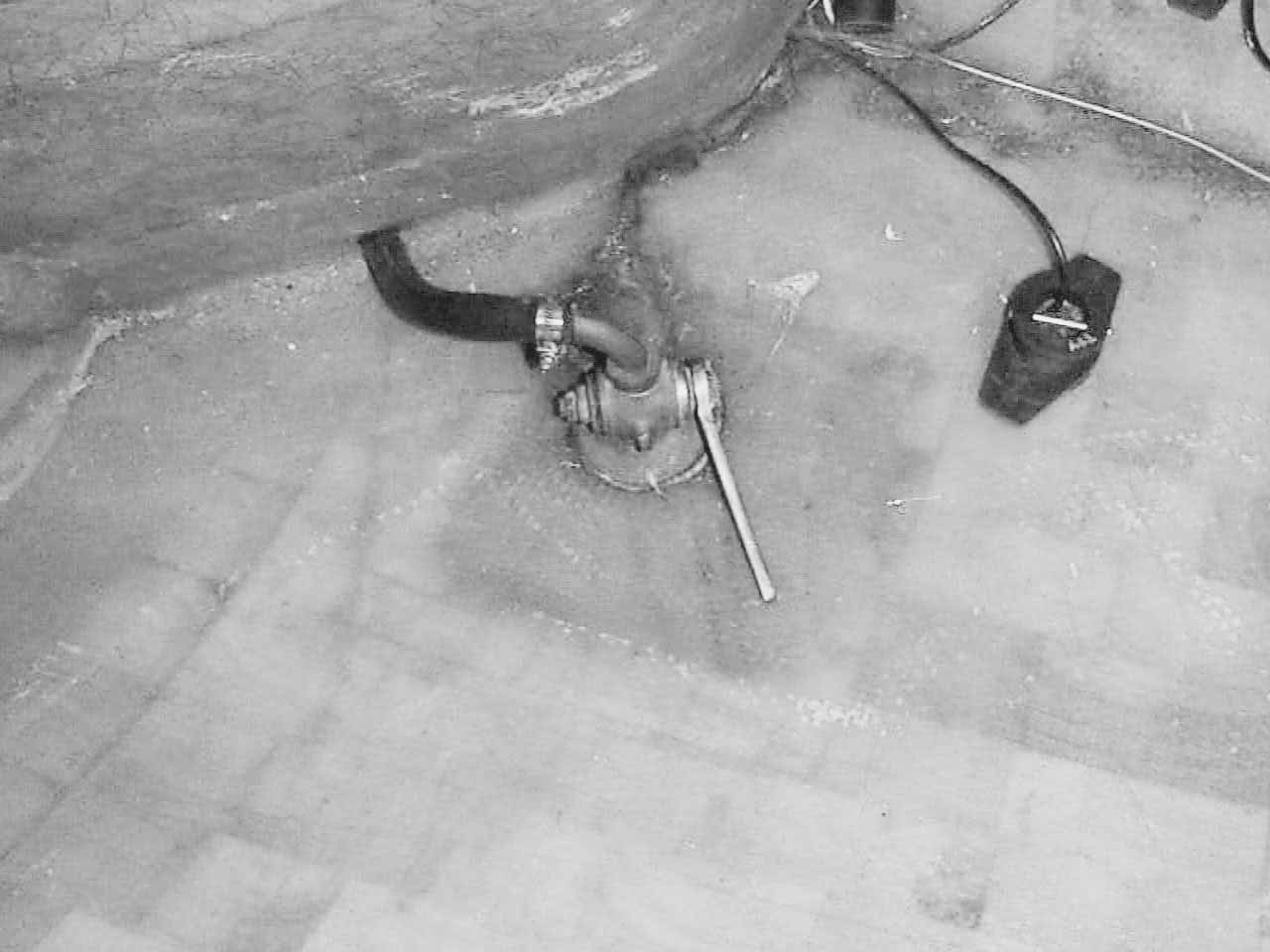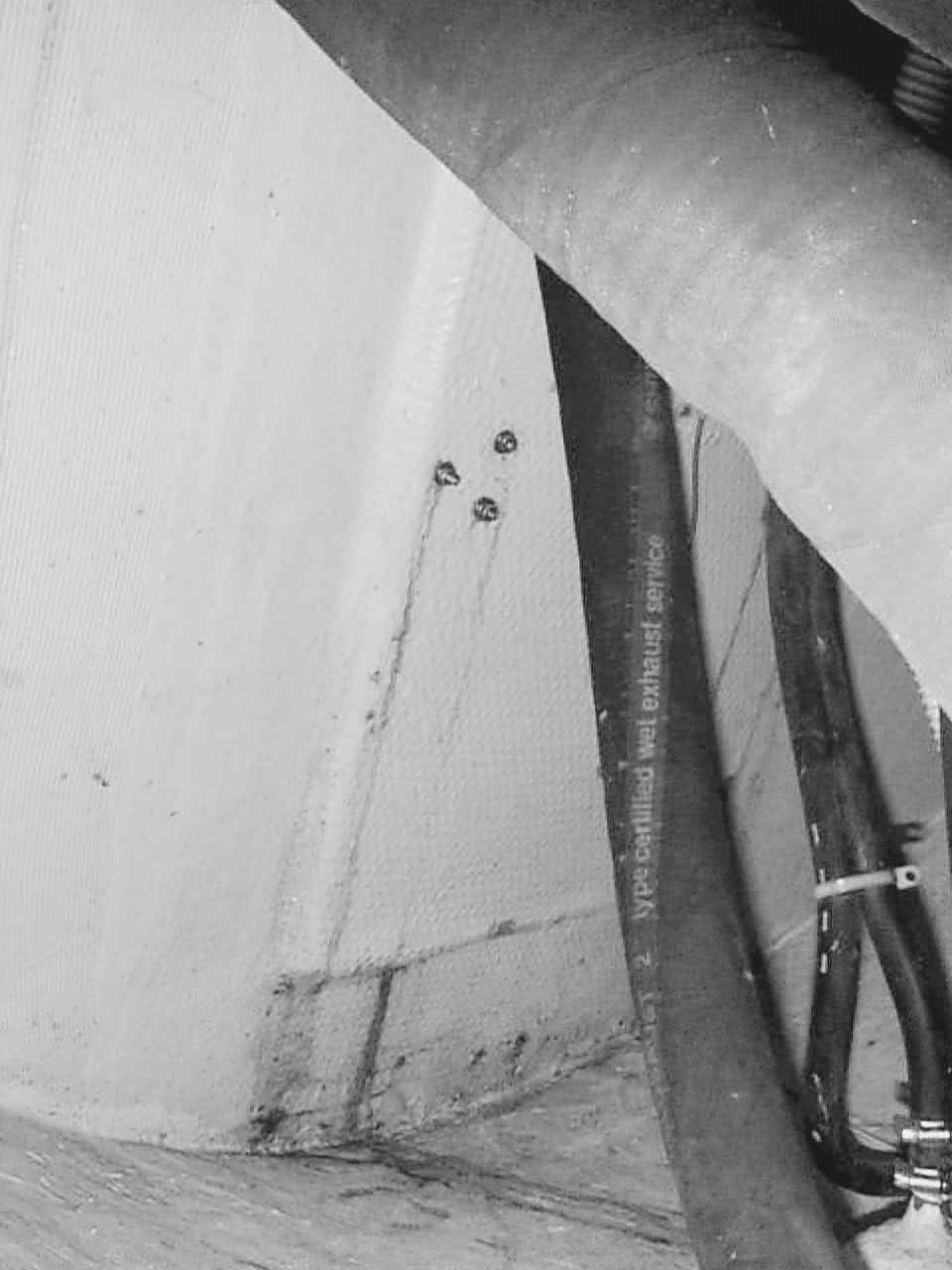Cored Hulls
by Phil Peterson
In an effort to build a stronger, lighter hull, boat builders began constructing hulls with a cored material sandwiched between layers of fiberglass. While this is more labor intensive, the end product is a lighter and stiffer hull.
There are a number of material used for coring, including end grain balsa, Airex and Divinycell. In addition, plywood may be used in transoms, as well as in decks on boats of any length.
 |
| The photo above is from a 34 ft. sailboat,
and shows a good example of a balsa cored hull. The square patterns of the end grain balsa core is visible through the translucent fiberglass. Most builders paint the interior areas of the hull so the balsa core is usually not visible.
Note the dark square area around the bronze through hull fitting where the builder correctly did not use balsa core to preserve the integrity of the wood and to keep it dry. However, a depth sounder transducer was installed in the balsa cored area to the right of the bronze through hull fitting, which is not a preferred practice. However, the area was inspected using a moisture meter, and no moisture was found, indicating the balsa was still well sealed. |
End grain balsa has the advantage of being very light and stiff, but can absorb water if not completely sealed. It is best used above the waterline. Airex is a synthetic, also light, but more flexible. Divinycell, also a synthetic, is stiffer than Airex. Both synthetics are less prone to absorbing water. Plywood, while not as light, is stiff and gives light fiberglass sections an increased load carrying capacity, but it is also susceptible to water absorption.
Cored materials have been used successfully for a number of years, and can be without problems. However, as noted above, as the material can become wet and can delaminate. The result is a loss of strength in the hull.
Because the cored material is covered on both sides by fiberglass, it can be difficult to detect in a hull.
Generally, coring is not found in boats until the mid-30 ft. range. There may be a few exotic species for racing that do, but the vast majority of the smaller boats on Lake Superior and elsewhere simply aren't cored.
The easiest way to check for coring is a visual inspection of the interior of the hull where it may be possible to detect a ¼" to ½" thickness difference between the border between cored and non-cored areas. A good place to start looking is around through hull fittings, as it is good building practice not to put through hulls in a cored area and subject the core to a higher chance of water absorption. Other areas to look are beneath the forward V-berth, beneath settees and bunks, in hanging lockers, around the engine, in the cockpit lockers and anywhere else the hull interior is accessible for inspection.
A second method of checking for a cored material is by tapping the hull with a small plastic hammer. As the hammer (lightly) strikes the fiberglass hull, a clear, crisp report should be heard. If the report is dull and sounds like a watermelon, there may cored material that is wet. A hammer will not definitively tell you there is core material, but it will aid in finding wet and/or delaminated core.
A third method is with a moisture meter. Like the hammer, it will not tell you if the hull is cored, but it will indicate the presence of a wet core. Of course, these meters can give high readings caused by something other than moisture, including metal fittings and bottom paint.
 |
| The photo on the left is of an interior of a transom in a different 34 ft. boat, and plywood has been used as a stiffener at the center of the transom to support the backstay chainplate and boarding ladder mounts. Note how the fiberglass is raised in the area over the stiffener indicating the presence of the core material.
Gray colored water stains can be seen running down from the three through bolts securing the boarding ladder on the exterior of the transom. The stain is even darker where more water has drained out of the area at the bottom of the stiffener.
The area produced high moisture meter readings over the plywood stiffener, and subsequent core samples of the plywood revealed wet plywood. When repairs were made, the plywood was found to have delaminated from the fiberglass. |
A fourth way to determine if cored material is present is through destructive testing. This is simply drilling a ¼" hole into a suspected area of the hull from the interior, and visually inspecting the drill bit for traces of core material. It must be done with the owner's permission, and care must be taken to penetrate through the interior fiberglass layer and into the core, but not through the exterior fiberglass of the hull. The small holes are easily patched afterwards.
This past summer while conducting a pre-purchase survey on a 34 ft. boat, my hammer began giving a dull sound as it neared the keel. The outline of the area was marked and a moisture meter was used to confirm the findings. The hull interior was examined where accessible and raised areas were noted, indicating the hull was cored. At this point both the buyer and seller were advised that the hull coring was suspect, and the owner agreed to taking core samples. Approximately 20 holes were carefully drilled in suspect areas and the presence of water was confirmed. The sale of the boat was completed after adjustments were made to the purchase contract, and the hull is being repaired this winter.
While conducting a pre-purchase survey this fall on a different 34 ft. sailboat built by another manufacturer, the hammer reports gave no indication of any problems. However, a moisture meter gave elevated readings in the center of the transom. A visual inspection on the interior of the transom indicated a cored stiffener had been used in this area, and water stains were noted running down from boarding ladder fitting through bolts as well as out of the bottom of the stiffener area. The moisture meter also indicated an elevated moisture content, and the owner consented to taking core samples from the area. The samples produced wet plywood, and repairs were required. During repairs it was determined that the plywood had also delaminated from the fiberglass. The sale went through after the area was repaired.
Properly built using the correct materials, a cored hull can be a great advantage in providing a light, stiff boat for better sailing performance. However, when purchasing a boat, it is prudent to conduct a thorough inspection to determine the exact condition of the boat and the materials used.
Phil Peterson is a Certified Marine Surveyor and a member of the National Association of Marine Surveyors. His office is in Bayfield, Wisconsin, and he can be contacted at 715/779-0254.
Back to Articles
About Sailing Breezes Magazine
Please send us your comments!!
All contents
are copyright (c) 1999
by Northern Breezes, Inc. All information contained within is deemed reliable but carries
no guarantees. Reproduction of any part or whole of this publication in any form by
mechanical or electronic means, including information retrieval is prohibited except by
consent of the publisher.

